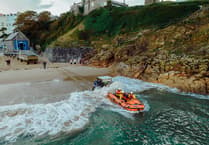Road users are being advised that they could face prosecution if they ignore signs warning that the Cleddau Bridge is closed to high-sided vehicles in bad weather.
Because of the strong winds over the past few days, the bridge has been closed intermittently to high-sided vehicles.
But it hasn’t deterred some road users who have continued to cross the 820-metre bridge despite the possibility of their high-sided vehicle being blown over.
“We are concerned about the dangerous situation these drivers are putting themselves in and others using the bridge. It may also invalidate motorists insurance by failing to properly comply with the signs” said Phil Baker, a Cabinet Member with Pembrokeshire County Council which operates the Cleddau Bridge.
“Once a closure to high-sided vehicles is implemented, the action we take is to set the closure signs, which are very prominent, to ‘Closed to High-Sided Vehicles’” explained Councillor Baker, the Cabinet Member for Infrastructure.
“That is what we are required to do by law, complies with the current Traffic Order for the closures and is the appropriate approach to warn motorists.”
Councillor Baker said additional measures would now be considered, such as the introduction of an ‘over-height’ detection system and installing barriers for when the bridge is closed to all traffic.
He continued: “In the meantime the message to all is that if the bridge is closed to high-sided vehicles, they should not take prohibited vehicles over the structure.”
“I don’t think people realise that, if they do transgress, they could be prosecuted and end up being fined or having points added to their driving licence. There are cameras installed on the bridge to monitor traffic flows so they cannot escape detection.”
The closure status of the bridge is determined by three main factors: wind speed, wind direction and the weather forecast.
Closure to high-sided vehicles is normally implemented once wind speeds reach 55 mph.
A high-sided vehicle is any vehicle more than 1.9 metres high. This includes lorries, transit vans, minibuses, land-rovers, and caravans.
Wind-sensitive loads such as bicycles, motor cycles and cars with roof racks are also not permitted to cross when a high-sided closure is in operation.
Closure to all vehicles and pedestrians is usually implemented once wind speeds are over 70mph.




